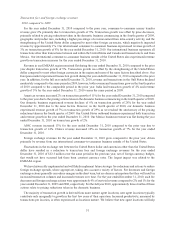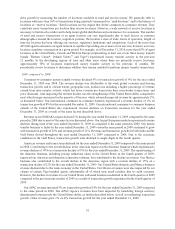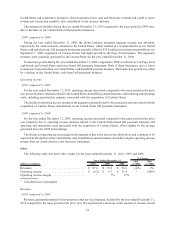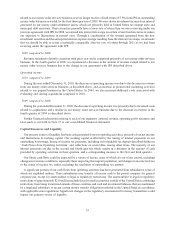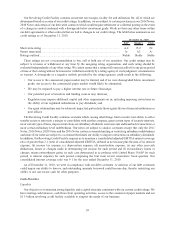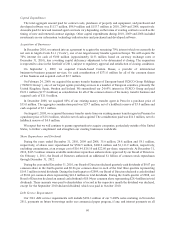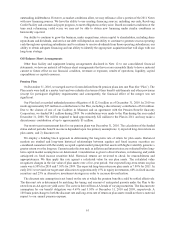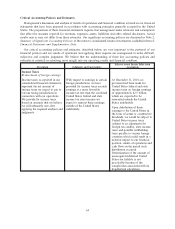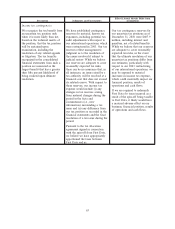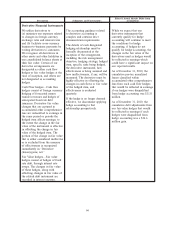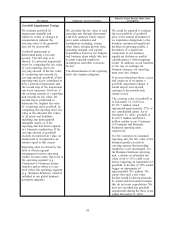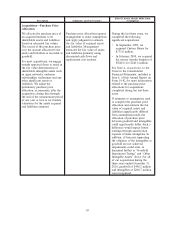Western Union 2010 Annual Report Download - page 63
Download and view the complete annual report
Please find page 63 of the 2010 Western Union annual report below. You can navigate through the pages in the report by either clicking on the pages listed below, or by using the keyword search tool below to find specific information within the annual report.outstanding indebtedness. However, as market conditions allow, we may refinance all or a portion of the 2011 Notes
with new financing sources. We have the ability to use existing financing sources, including our cash, Revolving
Credit Facility and commercial paper program, to meet obligations as they arise. Based on market conditions at the
time such refinancing could occur, we may not be able to obtain new financing under similar conditions as
historically reported.
Our ability to continue to grow the business, make acquisitions, return capital to shareholders, including share
repurchases and dividends, and service our debt will depend on our ability to continue to generate excess operating
cash through our operating subsidiaries and to continue to receive dividends from those operating subsidiaries, our
ability to obtain adequate financing and our ability to identify the appropriate acquisitions that will align with our
long-term strategy.
Off-Balance Sheet Arrangements
Other than facility and equipment leasing arrangements disclosed in Note 12 to our consolidated financial
statements, we have no material off-balance sheet arrangements that have or are reasonably likely to have a material
current or future effect on our financial condition, revenues or expenses, results of operations, liquidity, capital
expenditures or capital resources.
Pension Plan
On December 31, 2010, we merged our two frozen defined benefit pension plans into one Plan (the “Plan”). The
Plan assets were held in a master trust and were identical in terms of their benefit entitlements and other provisions
(except for participant eligibility requirements) and consequently, the financial effect of the merger was not
significant.
Our Plan had a recorded unfunded pension obligation of $112.8 million as of December 31, 2010. In 2010 we
made approximately $25 million in contributions to the Plan, including a discretionary contribution of $10 million.
Due to the closure of one of our facilities in Missouri and an agreement with the Pension Benefit Guaranty
Corporation, we funded $4.1 million during 2009. No contributions were made to the Plan during the year ended
December 31, 2008. We will be required to fund approximately $22 million to the Plan in 2011 and may make a
discretionary contribution of up to approximately $3 million.
Our most recent measurement date for our pension plans was December 31, 2010. The calculation of the funded
status and net periodic benefit income is dependent upon two primary assumptions: 1) expected long-term return on
plan assets; and 2) discount rate.
We employ a building block approach in determining the long-term rate of return for plan assets. Historical
markets are studied and long-term historical relationships between equities and fixed income securities are
considered consistent with the widely accepted capital market principle that assets with higher volatility generate a
greater return over the long run. Current market factors such as inflation and interest rates are evaluated before long-
term capital market assumptions are determined. Consideration is given to diversification, re-balancing and yields
anticipated on fixed income securities held. Historical returns are reviewed to check for reasonableness and
appropriateness. We then apply this rate against a calculated value for our plan assets. The calculated value
recognizes changes in the fair value of plan assets over a five-year period. Our expected long-term return on plan
assets was 6.50% for 2010 and 7.50% for 2009. The expected long-term return on plan assets is 7.00% for 2011. In
early 2011 we revised our target asset allocation to approximately 15% in equity investments, 60% in fixed income
securities and 25% in alternative investment strategies in order to increase diversification.
The discount rate assumption is set based on the rate at which the pension benefits could be settled effectively.
The discount rate is determined by matching the timing and amount of anticipated payouts under the Plan to the
rates from an AA spot rate yield curve. The curve is derived from AA bonds of varying maturities. The discount rate
assumption for our benefit obligation was 4.69% and 5.30% at December 31, 2010 and 2009, respectively. A
100 basis point change to both the discount rate and long-term rate of return on plan assets would not have a material
impact to our annual pension expense.
61


